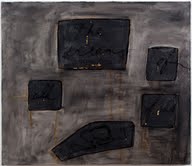
From the Muses of Helicon, let us begin our singing, that haunt Helicon's great and lofty mountain, and dance on soft feet around the altar of the mighty son of Kronos. This from Hesiod's Theogony. "Night bore hateful Doom and dark Fate and Death, She bore Sleep, and she bore the Tribe of Dreams...."
"We live as we dream," wrote Joseph Conrad, "alone." Mira Schor's recent exhibition at Marvelli, Voice and Speech, makes a compelling argument against Conrad's existentialist notions with paintings that are interrogations of thinking, speaking, writing and, of course, the act of painting.
In this exhibition of recent paintings, Schor explores the concepts of "voice" and "speech" in contemporary politics and art theory, inspired by an idea put forward in Michel de Certeau's The Practice of Everyday Life. De Certeau's theme is that there exists a knowledge that precedes theory and which retains "voice" even when "speech" attempts to subsume it. It is the knowledge that causes the city dweller to inscribe living patterns of usage onto the fixed grid of the planned city; it's the knowledge of the folkloric, of craft. He writes, "In turn, 'the voice' will also insinuate itself into the text as a mark or a trace, an effect of a metonymy of the body...a transitory figure, an indiscreet ghost, a 'pagan' or 'wild' reminiscence in the scriptural economy, a disturbing sound from a different tradition, and a pre-text for interminable interpretive productions."
Schor's recent works, such as "Voice and Speech" (2011), "Here/Then" (2011), "Conditions of Practice" (2011), and "The Space Where Painting Used to Be" (2010) are philosophical meditations on the place of painting in contemporary culture, on the visual artist as a thinking being, and on painting as a sensual space for visualizing thought. These paintings have a pastoral setting: in each work a figure walks or reclines under a flanged, tree-like diagrammatical structure, in a garden of sorts, reading, writing or simply existing in space. The moment of the activity is caught in an intensely worked surface, in washes of malachite greens and lead whites, suggesting nature without describing it. "Here/Now, There/Now" depicts Schor's thoughts upon reading a book entitled What is Contemporary Art?, which she extrapolated on to ask, "Where is contemporary art?" and determined that the contemporary, the now, is not here, where she is (in the West, in the tradition of painting), but there, in a global world of new media. She felt that the Western traditions of painting and, in particular, the New York School style of art she emerged from, are part of a "then" and that the elusive, desired "now" is always going to be somewhere "out there." Her little avatar-like figure can only return to, in Voltaire's words from Candide, "il faut cultiver notre jardin" and paint the space she herself occupies.
A grouping of four new canvases -- "The Dreams of All of Us" (2012), "Negative of the Positive" (2012 [above]), "The Darkest Part of the Night" (2012), and "This is the Future" (2012) -- presents variations on the theme of the reading/sleeping/dreaming avatar, surrounded by rectilinear shapes, or compartments, which contain the words "the dreams of us all." In "Night and Future" the words have been redacted, as if lost or faded, like a dream upon wakening. The reading figure in "Dreams" becomes a reclining, sleeper in "Negative"; the black-on-black composition of this work brings to mind Malevich, and the rebus composition evokes that surreal sleeper Magritte. "Negative" stands out from the series, mostly by its stark geometries and funereal tone, suggesting nothing so much as a meditation on the difference between death and sleep. In contrast to the more earthly "gardens," Schor depicts that moment of falling asleep, where the body is left behind, and we wander off, all of us, perhaps into some vaster collective unconscious to dream -- all alone together.
